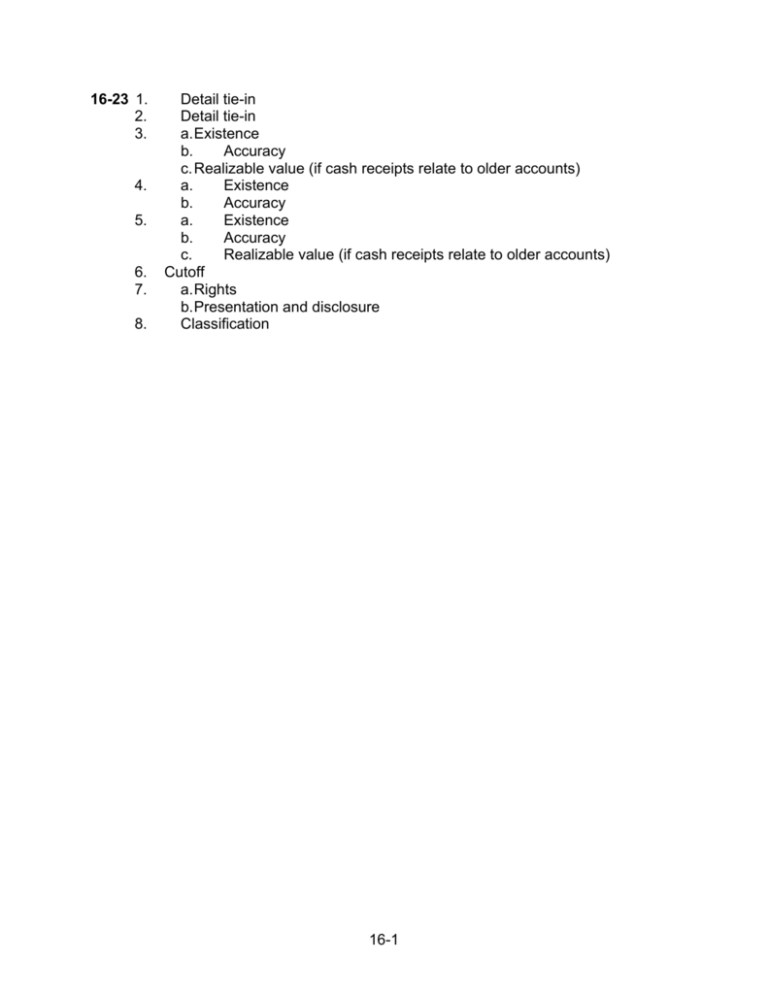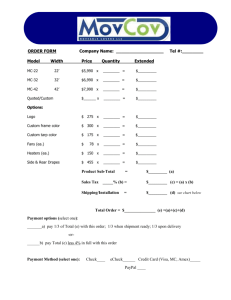16-1 16-23 1. Detail tie-in 2. Detail tie
advertisement

16-23 1. 2. 3. 4. 5. 6. 7. 8. Detail tie-in Detail tie-in a. Existence b. Accuracy c. Realizable value (if cash receipts relate to older accounts) a. Existence b. Accuracy a. Existence b. Accuracy c. Realizable value (if cash receipts relate to older accounts) Cutoff a. Rights b. Presentation and disclosure Classification 16-1 16-27 a. b. A shipment should be recorded as a sale on the date of shipment or the passing of title, whichever occurs first. Ordinarily, a shipment is considered a sale when it is shipped, picked up, or delivered by a common carrier. The sales invoice number can be ignored, except to determine the shipping document number. INVOICE NO. SHIPPING DOCUMENT NO. MISSTATEMENT IN SALES CUTOFF OVERSTATEMENT OR UNDERSTATEMENT OF AUG. 31 SALES August sales 4326 4329 4327 4328 4330 2164 2169 2165 2168 2166 none 1,914.30 none 620.22 none 2,534.52 2163 2167 2170 2171 2172 4,641.31 106.39 none none none 4,747.70 overstatement overstatement September sales 4332 4331 4333 4335 4334 Net understatement understatement understatement 2,213.18 Adjusting entry Accounts receivable Sales c. 2213.18 2213.18 After making the type of cutoff adjustments shown in part b, current year sales would be overstated by: Amount of sale 2168 2169 2170 2171 2172 620.22 1,914.30 852.06 1,250.50 646.58 5,283.66 16-2 16-27 (continued) d. The best way to discover the misstatement is to be on hand on the balance sheet date and record in the audit working papers the last shipping document issued in the current period. Later, the auditors can examine shipping documents before and after the balance sheet date to determine if they were correctly dated. An alternative, if there are perpetual records, is to follow up differences between physical inventory counts and perpetual record balances to determine if the cause was end of the period cutoff misstatements. Assume, for example, that there were 626 units of part X263 on hand August 31, but the perpetual records showed a total of 526, and a shipment of 100 units included on the perpetual August 31, that is a likely indication of a September shipment that had been dated August 31. The following procedures are usually desirable to test for sales cutoff. 1. 2. 3. e. Be present during the physical count on the last day of the accounting period to determine the shipping document number for the last shipment made in the current year. Record that number in the working papers. During year-end field work, select a sample of shipping documents preceding and succeeding those selected in procedure 1. Shipping documents with the same or with a smaller number than the one determined in procedure 1 should be included in current sales. Those with document numbers larger than that number should have been excluded from current sales. During year-end field work, select a sample of sales from the sales journal recorded in the last few days of the current period, and a sample of those recorded for the first few days in the subsequent period. Trace sales recorded in the current period to related shipping documents to make sure that each one has a number equal to or smaller than the one in procedure 1. Similarly, trace sales recorded in the subsequent period to make sure each sale has a related shipping document number greater than the one in procedure 1. The following are effective controls and related tests of controls to help prevent cutoff misstatements. 16-3 16-27 (continued) CONTROL TEST OF CONTROL (1) Policy requiring the use of prenumbered shipping documents. Examine several documents for prenumbering. (2) Policy requiring the issuance of shipping documents sequentially. Observe issuance of documents, examine document numbers and inquiry. (3) Policy requiring recording sales invoices in the same sequence as shipping documents are issued. Observe recording of documents, examine document numbers and inquiry. (4) Policy requiring dating of shipping documents, immediate recording of sales, and dating sales on the same date as the shipment. Observe dating of shipping documents and sales invoices, and timing of recording. (5) Use of perpetual inventory records and reconciliation of differences between physical and perpetual records. Examine worksheets reconciling physical counts and perpetual records. 16-4






